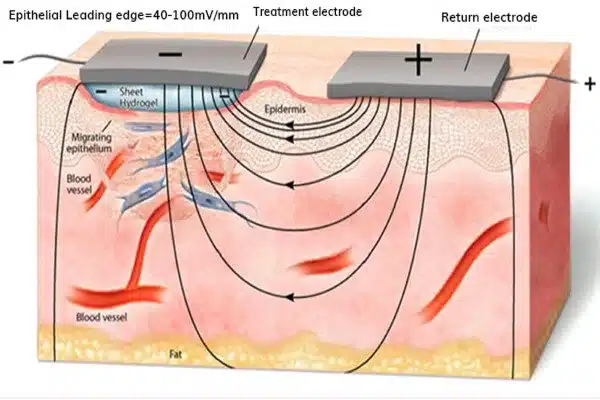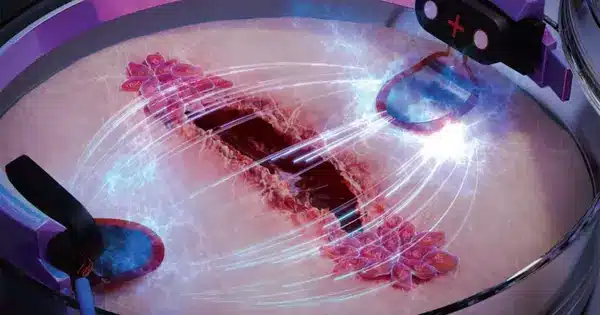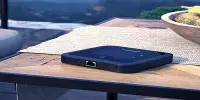For centuries, electricity has been used in medicine, and it has been shown to have a variety of beneficial effects on the human body, including the ability to accelerate wound healing. Electrotherapy is one technique for accomplishing this.
Chronic wounds are a major health concern for diabetic patients and the elderly, and in severe cases can result in amputation. Researchers from Chalmers University of Technology in Sweden and the University of Freiburg in Germany used electric stimulation to develop a method that speeds up the healing process, allowing wounds to heal three times faster.
An old Swedish proverb states that one should never ignore a minor wound or a friend in need. A small wound does not usually cause serious complications in most people, but many common diagnoses make wound healing much more difficult. Diabetes, spinal injuries, and poor blood circulation all impair wound healing ability. This means a greater risk of infection and chronic wounds – which in the long run can lead to such serious consequences as amputation.
A group of researchers from Chalmers and the University of Freiburg has now developed a method for speeding up the healing process by using electric stimulation.
“Chronic wounds are a major societal issue that we don’t hear much about. Our discovery of a method that may heal wounds up to three times faster could be a game changer for diabetics and the elderly, among others, who frequently suffer greatly from wounds that won’t heal,” says Maria Asplund, Associate Professor of Bioelectronics at Chalmers University of Technology and project leader.
Our discovery of a method that may heal wounds up to three times faster could be a game changer for diabetics and the elderly, among others, who frequently suffer greatly from wounds that won’t heal.
Maria Asplund
Electric guidance of cells for faster healing
The researchers relied on an old theory that electric stimulation of damaged skin could be used to heal wounds. The idea is that skin cells are electrotactic, which means they’migrate’ in a specific direction in electric fields. This means that when an electric field is applied to skin cells in a petri dish, the cells stop moving randomly and begin moving in the same direction. The researchers looked into how this principle can be used to electrically guide cells to help wounds heal faster. The researchers were able to compare wound healing in artificial skin using a tiny engineered chip, stimulating one wound with electricity and allowing the other to heal without electricity. The distinctions were striking.
“We were able to show that the old hypothesis about electric stimulation can be used to make wounds heal significantly faster. In order to study exactly how this works for wounds, we developed a kind of biochip on which we cultured skin cells, which we then made tiny wounds in. Then we stimulated one wound with an electric field, which clearly led to it healing three times as fast as the wound that healed without electric stimulation,” Maria Asplund says.

Hope for diabetes patients
The researchers also focused on wound healing in relation to diabetes, a growing health issue worldwide. According to the World Health Organization (WHO) and the International Diabetes Federation, one in every eleven adults today has diabetes.
“We looked at diabetes wound models to see if our method could be effective even in those cases.” When we induced diabetes in the cells, we discovered that the wounds on the chip heal very slowly. “However, with electric stimulation, we can accelerate healing to the point where diabetes-affected cells almost match healthy skin cells,” Asplund says.
Individualised treatment the next step
The Chalmers researchers recently received a large grant that will allow them to continue their research in the field and, in the long run, enable the development of marketable wound healing products. Similar products have been developed in the past, but more basic research is required to develop effective products that generate sufficient electric field strength and stimulate in the appropriate manner for each individual.
“We are now looking at how different skin cells interact during stimulation, to get a step closer to a realistic wound,” Asplund and her colleagues explain. “We want to create a concept that can’scan’ wounds and adjust stimulation based on the individual wound. We are convinced that this is the key to effectively helping individuals with slow-healing wounds in the future,” Asplund says.
More about the study:
- “Bioelectronic microfluidic wound healing: a platform for investigating direct current stimulation of injured cell collectives”was published in the journal Lab on a Chip. The article was written by Sebastian Shaner, Anna Savelyeva, Anja Kvartuh, Nicole Jedrusik, Lukas Matter, José Leal and Maria Asplund. The researchers work at the University of Freiburg in Germany and Chalmers University of Technology.
- The researchers discovered that wound healing on artificial skin stimulated with an electric current was three times faster than on natural skin. The electric field was low, around 200 mV/mm, and had no effect on the cells.
- The researchers’ method is based on a microfluidic biochip that allows artificial skin to be grown, stimulated with an electric current, and studied in an efficient and controlled manner. The concept enables researchers to run multiple experiments concurrently on the same chip.
















